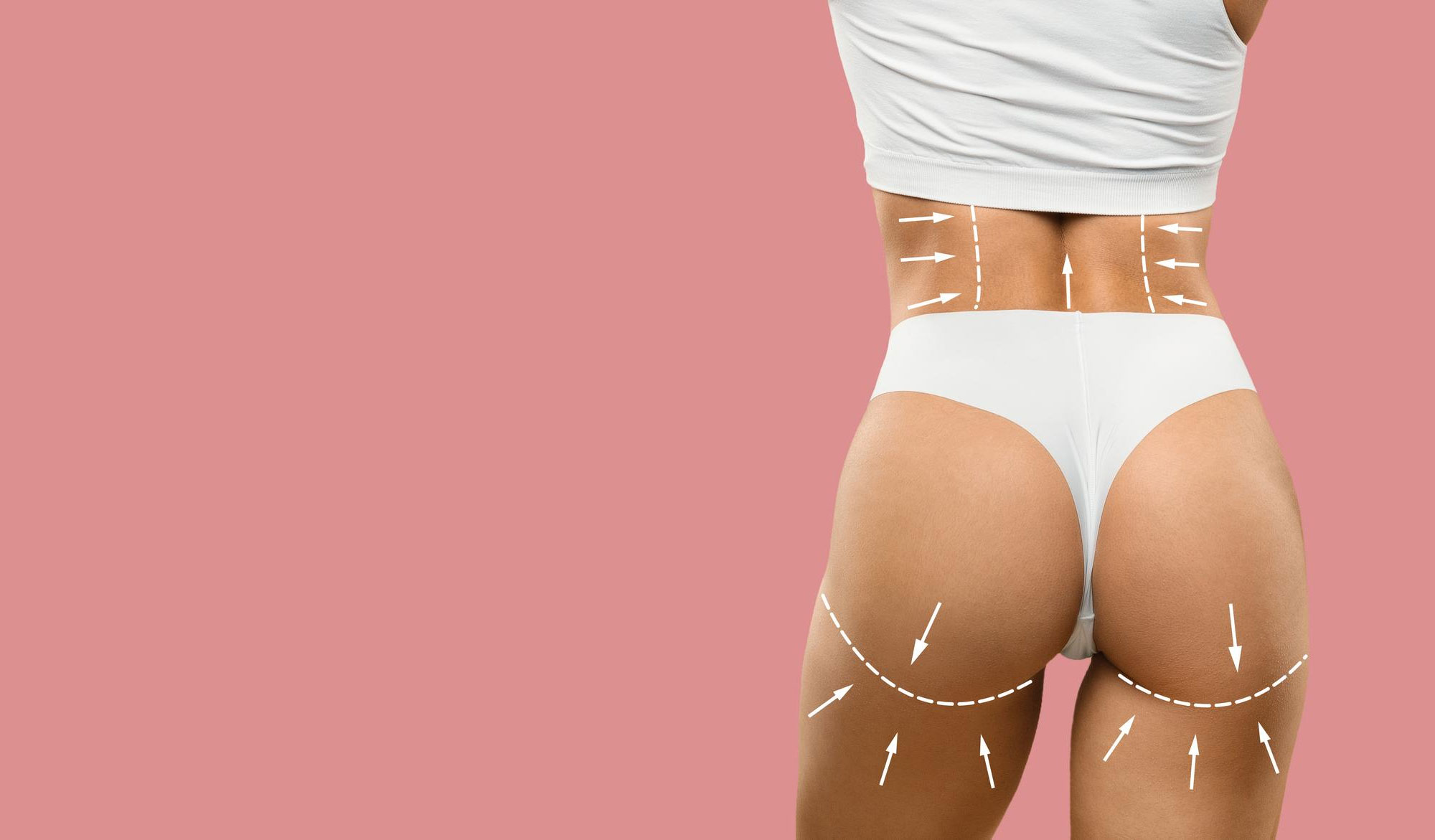What is Arm Lift (Brachioplasty)?
The skin and subcutaneous tissue in our body is like a kind of fabric. Just like the sleeve of a shirt, this fabric (skin) can stretch and sag over time. The aim of arm lift surgery is to cut away the excess fabric and reshape the sleeve of the shirt by narrowing it again. In more medical terms, the excess skin and fat tissue accumulated in the upper arm is surgically removed and the remaining tissue is stretched and reshaped. In this way, it is aimed to achieve a firmer, smoother and contoured appearance of the arms.
Skin elasticity decreases over time. This means that the skin's ability to recover itself also decreases. Therefore, the sagging skin remains in the area where we expect tightening. The aim of arm lift surgery is to tighten this loose skin and make the contours of the underlying muscles more prominent. Thus, the "saggy arm" appearance that we cannot hide even with long-sleeved clothes and that we feel uncomfortable when we see it in the mirror can be eliminated.
Who is a Suitable Candidate for Arm Lift Surgery?
The answer to this question is based on personal differences, because everyone's body structure, skin elasticity and expectations are unique. Nevertheless, in general terms, those with the following characteristics are likely to benefit from arm lift surgery:
People who do not experience weight fluctuations and have a relatively stable weight
For example, people who have been at their ideal weight for a long time or who are determined to maintain it after reaching their target weight are generally considered more suitable for this surgery. Otherwise, gaining and losing weight again after surgery may cause new sagging in the shape of the arms.
People with significant sagging or fat accumulation in their upper arms
Sometimes a "bat wing" like appearance occurs in the upper arm area. This is related to both sagging skin and the accumulation of resistant fat tissues there. Despite diet and exercise, this part is often stubborn; arm lift surgery may be preferred for this reason.
People in good general health and non-smokers
Smoking brings with it many factors that can negatively affect wound healing. Therefore, it is recommended not to smoke for a smoother and faster healing of the surgery. In addition, if there are chronic diseases such as diabetes, surgery is planned under the approval and control of a doctor.
Those with realistic expectations
Arm lift surgery does not give the arms a perfect shape as if a magic wand had touched them. Surgery leaves incisions and scars; however, these scars can be lightened over time and can be made as little visible as possible with the right care. After the surgery, the general appearance of the arms improves significantly and the person can have a more fit appearance. The expectation should not be "I will look like my 20-year-old self" but "I will look much better than my current situation".
How is Arm Lift Surgery Performed?
Although arm lift surgery can be performed with different techniques, it is based on a general surgical principle:
Anesthesia Selection
General anesthesia is usually preferred to ensure the patient's comfort before surgery. In some cases, regional anesthesia, which numbs only the arm area, and light sedation may also be used. The decision depends on the person's health condition and the doctor's recommendation.
Incision Planning
The incision is usually made on the inside of the arm. Although the aim here is to make the wound visibly inconspicuous, the length of the scar may vary depending on the scope of the surgery. It is possible to make a small incision extending only to the armpit or a long incision from the elbow to the armpit.
Removal of Excess Fat and Skin
After the incision is opened, liposuction (fat removal) technique can be applied to remove excess fat tissue. The loose skin is then cut away. It is like cutting away the excess fabric from the garment with scissors and sewing the remaining piece more neatly.
Textural Correction and Tightening
After the fatty tissue and skin are removed, the shape of the arm is reshaped by applying internal sutures to the underlying tissue. This stage is important to ensure that the arm does not sag in the future and to support the skin.
Incision Closure
The incisions are usually closed with techniques called hidden sutures (no knots on the skin surface) or sometimes skin staples or conventional sutures can be used. The area is then dressed and a bandage or compression garment is applied to support the arm.
Awakening and First Checks
On average, the duration of the operation can vary between 1-3 hours. After waking up, you may need to rest in the hospital for a while. In the first controls, the arm area is closely monitored to prevent complications.
Which Techniques are Used in Arm Lift Surgery?
The technique applied in arm lift surgery varies depending on the degree of sagging of the arm, the structure of the skin and the person's expectations. Some of the most commonly used techniques are as follows:
Liposuction Assisted Arm Lift
If the elasticity of the skin is partially good but there is only a problem of excess fat tissue, the excess fat can be removed with liposuction and the skin can be tightened with minimal incisions. This method is preferred in patients with relatively little sagging.
Minimal Incision (Short Incision) Brachioplasty
It can be preferred for people with mild to moderate sagging. The incision is usually hidden in the armpit (axilla). Both liposuction and limited skin removal are involved. Although the scar is smaller, this method may not be sufficient in very severe sagging.
Traditional (Standard) Arm Lift
A long incision is made from the elbow to the armpit. It is ideal for removing large amounts of excess skin and fatty tissue. The scar extends along the inside of the arm. However, with this method, the sagging problem is almost completely eliminated; the postoperative scar may become less noticeable over time with adequate skin care.
Extended Brachioplasty
It is not limited to the upper arm, but is performed through an incision extending from the armpit to the side wall of the chest when necessary. It is especially preferred for patients with sagging in the side breast area after large weight loss.
L-Brachioplasty and Jaws Brachioplasty
These are techniques that surgeons have developed to distribute tissue tension in different directions and to position the scars more advantageously. With these techniques, shaping of the arm and side chest wall can be done more comprehensively, and the visibility of the scars is also reduced.
What to Expect During the Recovery Process?
As with any surgery, paying attention to the healing process after arm lift affects the quality and longevity of the result. The following points are generally taken care of in the postoperative period:
Compression garment
After the operation, a special corset or bandage is used to slightly compress the arm. This garment supports the surgical site and helps reduce swelling and bruising. Just as a cake baked in the oven keeps its form in the mold, the arm is shaped in a healthy way.
Pain and Discomfort Management
Mild to moderate pain, tension, burning sensation or swelling in the arm area after surgery is considered natural. Painkillers and antibiotics recommended by the doctor will help to make this process more comfortable. In addition, keeping the surgical site elevated (e.g. positioning the arm above the level of the heart) reduces edema.
Return to Daily Activities
In the first few days, the arm should not be strained as much as possible. Light walks and daily activities can usually be repeated gradually after 1 week. However, it is recommended to wait at least 4-6 weeks for heavy lifting, intense exercise or sports where the arm is used intensively. This time varies according to the size of the surgery and the speed of the person's recovery.
Wound Care
Keeping the incision sites clean and dressing them regularly is of great importance. Showering is usually possible after 2-3 days, depending on the water resistance of the bandages. Stitches are removed on the dates determined by the doctor or the stitches used may dissolve spontaneously.
Care of Scars
After arm lift surgery, the scar usually remains on the inner side of the arm. Over time, the scar color lightens and becomes less prominent. To minimize the appearance of scars, silicone-based creams, some laser applications or other methods recommended by the physician may be helpful.
What are the Risks and Complications?
Arm lift surgery, like any other surgical procedure, involves some risks. Knowing these risks can help to approach the process more consciously:
Bleeding and Hematoma
As with any surgery, there is a risk of bleeding because tissue is cut. Bleeding can accumulate under the skin and lead to blood accumulations called "hematomas". In such a case, this accumulation may need to be drained with additional intervention.
Infection
Although the risk of infection varies depending on the nature of the surgery, it is generally low. It is possible to reduce this risk by paying attention to postoperative dressing and hygiene rules and using prescribed antibiotics regularly.
Wound Healing Problems
The skin may heal more slowly or with problems in some people. There may be dehiscence or crusting, redness and edema. This risk is higher in smokers.
Sensory Changes
Temporary numbness or tingling may occur as a result of nerve branches on the inner side of the arm being affected during surgery. It usually improves over time, but permanent numbness may occur in rare cases.
Scar Problems
In some people, the scars may become more raised, red or itchy (hypertrophic scarring or keloids). Genetic predisposition is an important factor. It is possible to alleviate this appearance with the right care and additional treatments to be applied by the physician.
Asymmetry or Irregular Appearance
Both arms may not be saggy to the same extent before surgery. Slight asymmetry may also remain after surgery. Naturally, it is rare for both halves of the body to be exactly the same, but an experienced surgeon will minimize this difference.
How Permanent are the Results?
The results of arm lift surgery may vary in the long term depending on the person's genetic factors, skin structure and lifestyle. Basically, after the excess skin is removed, the body has difficulty returning to its previous state; therefore, there is a permanent effect. However, it is important to pay attention to the following situations:
Weight Balance
In order to maintain the tightened arm structure after surgery, it is important not to disturb the weight balance. The skin of the arm can stretch again when the cycle of weight gain and loss begins again.
Aging Process
As age progresses, there may be a natural tendency for the skin in the arm area to sag, as in every part of the body. In other words, the beneficial outcome of the surgery slows down and improves this process, although it does not reset it.
Exercise and Muscle Development
Regular exercise of the arm muscles (e.g. light weight lifting, Pilates, swimming) keeps the tissue under the skin more vital. Correct planning of exercises after surgery increases blood circulation in the arm area, contributing to the healing process and providing a more toned arm structure in the long term.
Sun Rays and Skin Care
The sun's harmful UV rays reduce skin elasticity all over the body, including the skin of the arms. It can also trigger darkening of the color of surgical scars. Therefore, it is important to use protective products and avoid prolonged exposure to sunlight.
In general, the improvement in the appearance of the arms after surgery is noticeable for many years. With supportive factors such as regular exercise, healthy diet and skin care, these results can be maintained for even longer.
How Long Does It Take to Return to Social Life After Surgery?
Arm lift surgery is a procedure that does not prevent the person from social life for a very long time. However, the exact duration may vary depending on the scope of the surgery and the person's constitution:
1-2 weeks: Light daily activities and desk work can usually be started. Although edema and bruises on the arms may persist to some extent, they usually do not prevent the person from going out easily and shopping for groceries.
Within 3-4 Weeks: It becomes possible to return to more active activities and light-paced sports. Provided that the arms are not overloaded, the exercise routine can be started in small steps.
6 Weeks and After: More demanding activities such as heavy lifting, intense training, fast-paced arm movements or swimming can be done easily after this period.
Long Term: The arm area is largely settled in terms of shape and aesthetics. Dressings and controls are also completed. It may take a few months for the scars to fade and the surgical line to match the skin.
What Should I Pay Attention to in Daily Life?
Following the arm lift surgery, it is possible to speed up the healing process and achieve better aesthetic results by paying attention to some tricks:
Bra and Clothing Selection
Especially if the armpit area is included in the surgery, cotton and comfortable clothes that do not squeeze the armpit should be preferred. Narrow straps can cause irritation and additional discomfort in the area.
Sleep Position
In the first days after surgery, lying on your back and keeping your arms slightly elevated will help reduce edema. Lying on your side or face down can put pressure on the suture area.
Water Consumption and Balanced Nutrition
Drinking plenty of water helps the skin to recover and the metabolism to work fast. A diet high in protein, vegetables and fruits accelerates tissue healing.
Continue Doctor Check-ups
Post-operative check-ups are essential for the management of processes such as suture removal and evaluation of scars. Following the doctor's recommendations ensures early detection of possible complications.
Will Sagging Occur Again After Arm Lift?
This is a very frequently asked question. Since excess skin is surgically removed, serious sagging is not expected again in the short and medium term. However, it should not be forgotten that the body is a living organism and reacts to external factors and aging. Processes such as excessive weight gain and loss, gravity and loss of skin elasticity can cause minor sagging over the years. Adopting healthy living habits, weight control and regular exercise significantly increase the permanence of the surgery.
Should I Look for a Solution with Arm Lift or Sports?
Exercise is the most natural way to gain muscle mass and shape the body. However, arm sagging is often not only related to muscle weakness. The "excess skin" caused by loss of skin elasticity, accumulation of adipose tissue or large weight losses may not be eliminated by sports alone. Sport strengthens muscle tissue under the existing skin and helps to maintain skin firmness to some extent. However, if there is significant excess skin, surgery offers a more effective and permanent solution.
The most ideal approach is to try to get the body in shape in general with exercise and a healthy diet, but if there is stubborn sagging or excess fat in the area, it is necessary to resort to arm lift surgery.



















